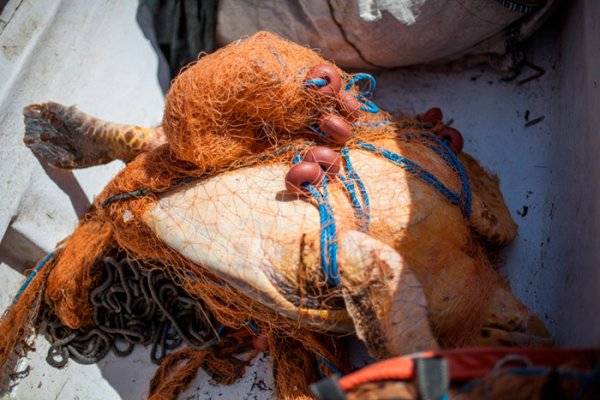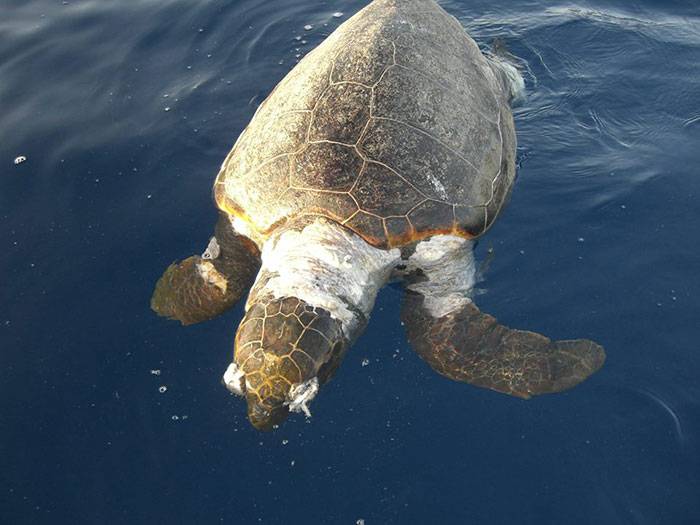
Adult female loggerhead turtle caught in a trammel net, Iskele, North Cyprus. Photographer Olkan Ergüler
The Marine Turtle Conservation Project in North Cyprus is a collaboration between the Society for Protection of Turtles, The North Cyprus Environmental Protection Department and the University of Exeter’s Marine Turtle Research Group. Since 1992 the group have undertaken monitoring and protection of loggerhead and green turtle nesting sites across the North Cyprus coast and in recent years, green turtle nesting numbers have increased significantly in response to these conservation efforts.
I started volunteering at MTCP in 2003, have had a managerial role in the project since 2008. I begun a part time PhD in 2009 to investigate the interaction between Mediterranean artisanal fisheries and higher marine vertebrates, in particular sea turtles and dolphins. By recording and undertaking necropsies, carrying out on-board observations and anthropological surveys in fishing communities, I quickly realised that the main source of sea turtle mortality on Cyprus was from bottom-set nets, in particular those targeting spinefoot, a Lessepsian migrant and this was the topic of my first chapter.
Since 2001 MTCP has been tracking both loggerhead and green turtles by satellite telemetry and I was tasked with writing up the loggerhead tracking data as part of my thesis and these results were recently published here.

Twenty seven turtles were tracked. We chose a wide range of female sizes, tracked from many locations and across the whole nesting season, so as not to bias our sample.
The main foraging sites were in Cyprus, Syria, Egypt, Libya and Tunisia. One turtle foraged in Lebanon. Turtles foraged on the sea bed on continental shelves in waters ranging from 2m to 120m depth.
Interestingly, turtles tracked after depositing their first clutch, went on to nest in Turkey, Syria and Israel, only depositing clutches in Cyrus en route to other areas. Other tracking studies may have missed this behaviour, since quite often, devices are preferably attached during the final clutch (loggerheads lay 2-5 clutches during a season), in order to target the life of the transmitter towards mapping foraging sites.
One turtle died before leaving North Cyprus waters. The carcass was retrieved and a necropsy revealed that the turtle had likely drowned in local set nets shortly after laying its final clutch. The death of two others was attributed to drowning in small-scale fishing operations on the basis of their locations and water depth in relation to fisheries, behaviour and by examining the rates of messages received by the ARGOS system. Other devices may have failed early due to death of the study animal, since the death of the turtle in North Cyprus and perhaps others could not be detected remotely.
We examined the distribution of foraging sites according to available fisheries bycatch information and this revealed that bottom-set nets such as those implicated in Cyprus, are probably the main source of mortality across the region.
Given the unstable local situation on the ground in many of the countries hosting these loggerheads, the research and mitigation required to reduce loggerhead tolls is unlikely to occur in the near future. It is therefore all the more important that nest protection schemes in Greece, Turkey and Cyprus continue and that development of nesting habitat is halted. However, with detailed information already published on fishery-turtle interactions, Cyprus is well situated to begin to mitigate its turtle bycatch.
Robin Snape (Centre for Ecology and Conservation, University of Exeter, UK, Society for Protection of birds and Nature: KUŞKOR, North Cyprus and Socıety for Protectıon of Turtles: SPOT, North Cyprus). 13 April 2016.
Footnote: The focus of OSME is birds, but there are many conservation issues that cut across taxa. Whilst this excellent guest blog from Robin Snape focuses on turtles, there are obvious implications for seabird-fishery interactions across the OSME region.
Dr Rob Sheldon, Chairman, OSME
POST SCRIPT from Robin Snape: this photo was taken yesterday by a fisherman (Dogan Kandili) who found this female loggerhead floating dead at sea which is extremely common. When they are floating like this with a transmitter attached, the rate of messages and behaviour change such that we can confirm death.
